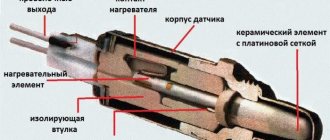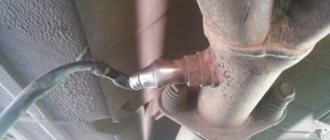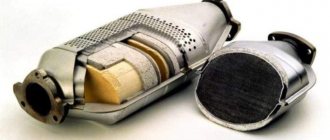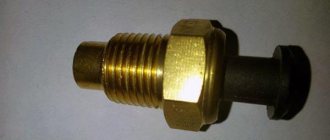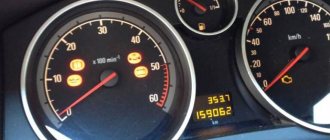Car self-diagnosis
- First you need to sit in the driver's seat and hold down the odometer button on the speedometer.
- Then insert the key into the ignition and set it to the first position.
- After turning the key, you must release the pressed button. This will cause the needles on the speedometer, tachometer and other gauges to move quickly.
- Then you need to press the odometer key again and release it. An inscription with the firmware version will appear on the device.
- After the third press of the odometer button, the VAZ 2114 error codes will start to light up on the display.
How to reset errors yourself
After self-diagnosis of errors and elimination of their causes on a carburetor or injection engine, a malfunction message may remain on the standard panel. If the problem has been deleted, this means that the code combination remains in memory. We'll look at the description of the faults below, and now we'll tell you how to remove the code from memory. To remove it after testing the device, when VAZ 2114 errors appear, the codes themselves must be written down. After this, the daily mileage reset button is pressed again, this will clear the fault from the control unit’s memory.
Resetting the "Check Engine" error
It often happens that the instrument panel 2114 8 or 16 valves displays a check error - engine malfunction, the orange icon is on. Self-diagnosis does not always allow you to accurately check and determine how to fix such a problem. To fix the problem and find a solution, you should perform more detailed diagnostics of the car using a computer and additional equipment. Perhaps, during diagnostics, an unknown error indicates a malfunction in the microprocessor, on-board network or sensors. After the problem is fixed, the receipt may remain.
The "Check Engine" indicator indicates a problem with the engine.
How to reset the fault code:
- First, turn on the ignition; you do not need to start the car engine.
- Then open the hood. Use a wrench to loosen the bolt on the negative terminal of the battery.
- Wait about one minute, after which the battery terminal must be replaced.
- Close the hood and turn off the ignition.
- After that, turn it on again and start the car engine. If the check remains, it should go out on its own after some time. If the instructions given did not work and the solution did not help, then you need to look for the cause of the problem and fix it.
Meaning and interpretation of error codes
To read the faults, first consider the list with a table of UEr errors that self-diagnosis produces (the author of the video is Ivan Vasilyevich).
| Number | Description |
| 1 | Problems with the functioning of the microprocessor. |
| 2 | Self-diagnosis of the VAZ 2114 detected problems with the electrical wiring of the fuel level indicator controller. The signal level coming from the sensor may be too high or low. It is necessary to test the controller and check the wiring. |
| 4 | Increased voltage in the on-board network. |
| 8 | Low voltage. What to do: in this and in the previous case, the battery and generator must be checked. |
| 12 | There is a problem with the diagnostic indicator circuit on the instrument panel. |
| 13 | The control unit cannot detect the signal coming from the oxygen controller. |
| 14 | An increased signal is received from the refrigerant temperature controller. |
| 15 | The problem is in the operation of the coolant temperature sensor (coolant temperature sensor) - the on-board computer records a reduced signal level. |
| 16 | There is increased voltage in the car wiring. |
| 17 | Reduced voltage in wiring. |
| 19 | Problems have been reported in the operation of the crankshaft position sensor (CPS). An incorrect signal is sent to the control unit. |
| 21 | Problems with the operation of the TPS controller (throttle position sensor). There may be problems with the throttle valve. Check the connection circuit and sensor. |
| 22 | A reduced signal is sent from the TPS. |
| 23 | The intake air temperature controller gives an increased signal. |
| 24 | There are problems with the speed controller. Its failure can be diagnosed by a non-working speedometer. |
| 25 | Reduced signal from the incoming air temperature controller. |
| 27,28 | Incorrect signal coming from the CO sensor. |
| 33,34 | Malfunctions of the mass air flow sensor (mass air flow sensor). Check the flow meter connection circuit and its functionality. |
| 35 | The ECU has detected a deviation in the idle speed values. The sensor may be faulty. |
| 41 | Incorrect pulse coming from the phase controller. |
| 42 | Problems with the electronic ignition wiring. |
| 43 | An incorrect pulse is supplied from the detonation controller. |
| 44,45 | Problems with the composition of the combustible mixture. It can be depleted or over-enriched. |
| 49 | Check for vacuum loss. |
| 51,52 | Problems in the functioning of the PROM or RAM. |
| 53 | There is no CO controller pulse. Open circuit or sensor failure. |
| 54 | No impulse is received from the octane corrector controller. |
| 55 | When the load on the power unit is reduced, the ECU detects depletion. |
| 61 | Problems with the oxygen controller. |
These codes can add up; if you see the number 6, this may indicate errors 2 and 4, or if the number 9 is displayed, errors 1 and 8.
In order to immediately read and decipher problems when diagnosing, it is advisable to download and always carry with you a printout with a description. When diagnosing using a computer, codes on engine 21124 may differ depending on the car model. To read the codes, you need to know how they are supposed to be deciphered. Errors must be reset after they have been deleted (the video was filmed and published by the KV Avtoservis channel).
| Number | Decoding |
| p0102, p0103 | An incorrect pulse is supplied from the mass air flow sensor controller. This means you need to check the wiring. |
| p0112, p0113 | 112 or 113 - the incoming air temperature sensor needs to be replaced. |
| p0115-p0118 | Errors from 0115 to 0118 - the antifreeze controller sends an incorrect impulse. There may be problems with the wiring or the sensor itself. |
| p0122, p0123 | TPDZ. The controller is sending an incorrect signal. If the wiring is damaged, interference may occur. |
| p0130, p0131 | The lambda probe requires diagnostics and replacement. |
| p0135-p0138 | Error 0135 and higher - the lambda probe heating regulator needs to be replaced. |
| p0030 | The ECU reports problems in the electrical circuit in the area from the lambda probe heater to the converter. If error p0030 occurs, you need to test the electrical circuit and the sensors themselves. |
| p0036 | P0036 - a break in the wiring of the heating device DK-2 was detected. |
| p0300, p0302 | When codes 300 and 302 appear, the ECU reports a misfire. |
| p0301 | Gaps were detected in the cylinders of the power unit. Compression needs to be checked. |
| p0325 | The knock sensor is not working correctly. In particular, we are talking about a break in the connection wiring. |
| p0335, p0336 | P0036 error VAZ 2114 or 10335 - the DPKV has failed or its connection circuit is damaged. If the wiring is intact, then the sensor is replaced. |
| p0340 | Phase sensor malfunction. |
| p0341 | Error VAZ 2114 0341 means a problem with the camshaft controller. |
| p0342, p0343 | Problems with the phase controller. With such an error, detonation of the car engine is possible. Most likely, only replacement will solve the problem. |
| p0346 | P0346 VAZ error - also a problem with the phase regulator. |
| p0363 | P0363 - misfire of the combustible mixture was detected. In cylinders that refuse to work, the fuel supply is cut off. |
| p0422 | Failure to operate the neutralizing device. |
| p0443, p0444, p0445 | Malfunctions 0443, p0444 and 0445 - adsorber regulator, purge is not carried out. |
| p0480 | The engine cooling fan device has failed. The power unit may overheat if it is not replaced in a timely manner. Before replacing, you need to check the connection contacts to the wiring. |
| p0501-p0504 | Error 0501 VAZ 2114 and error code 0504 - the speed controller refuses to work. The device needs to be replaced. |
| p0505, p0506, p0507 | The idle speed sensor does not work or does not work correctly. Its failure can lead to floating idle speed. Possible engine tripping. The controller itself is tested and the wiring is checked. |
| p0607 | The knock controller operates intermittently. |
| p1135 | Error 1135 VAZ 2114 - you need to test the oxygen controller. |
| p6060 | Processor failure. If the fault remains after resetting the code, then the controller must be replaced. |
| p2020 | It is necessary to test the intake flap position sensor. |
| p1617 | Error 1617 - Rough road controller, wiring damage. |
| p1513 | There is a short circuit in the wiring of the idle speed sensor. It is necessary to test the electrical circuit and check the contacts. |
| p1602 | Failures in the voltage supply to the vehicle's electrical network are detected. |
| p0560 | Incorrect voltage level in the on-board network. This parameter can be overestimated or underestimated. The car battery, as well as the generator unit, are subject to testing. |
| p1514, p0511 | The appearance of these errors indicates a problem with a break or short circuit in the IAC (idle speed regulator) wiring. First of all, diagnose the sensor contacts, and then test the circuit, if possible. The sensor itself may also be damaged. |
| p1303 | P1303 - A detected misfire of the air-fuel mixture in the third cylinder is reported. The malfunction must be corrected as quickly as possible, since it can be critical for the neutralizer. |
| p1578 | Throttle valve malfunction. Literally, the problem stands for “zero adaptation parameter is outside the permissible value.” There are several options to solve the problem. The first thing you need to do is clean the throttle valve. If this does not help, then the throttle is adapted. To do this, you need to activate the ignition, and then start the engine after 40 seconds. Alternatively, you can test and tighten the contact terminals on the throttle. |
| p1621 | Malfunction of the RAM, memory problems in the control unit. Detailed testing of the computer is required. |
| p0650 | Problems in the control circuit of the on-board computer error code indicator State. |
| p2135 | P2135 - malfunction of the throttle assembly. If replacing the sensor and cleaning the damper did not help, then the problem may have to be solved by flashing the on-board computer. |
| p2187 | Lean mixture in internal combustion engine cylinders. You need to do a detailed diagnosis of the problem. |
How to find a fault
Checking the positive contact of the oxygen sensor heater
First of all, it is worth checking the voltage in the connecting block of the first lambda and the presence of oxides; it happens that after cleaning the contact with a special product, the problem goes away. It is also worth checking the performance of the sensor itself by measuring the resistance.
To check the lambda probe wire, you need to disconnect two parts of the connecting block. We do not touch the part that goes down to the “female” sensor, but take measurements on the “male” block, the wires of which lead to the ECU.
With the ignition on, use a multimeter to check what voltage is supplied through the wires from the computer to the sensor heating element. To do this, select the voltage measurement mode of 20 V on the device and take readings on the contacts one by one. We attach the black probe to ground to the body, and connect the red probe to the upper right contact (if the block is not twisted, this will be the positive contact of the sensor heater). It should show a little more than 12 V. The diagonally opposite, lower left contact also goes to the heater and it should show a voltage of no more than 3.27 V.
When connected to the upper left contact, the multimeter will show a very small value - 0.02 V. After this, connect the probe to the opposite, lower right contact - there the voltage should be about 0.45 V. This is the contact of the oxygen sensor, which analyzes the level of oxygen in the exhaust gases and transmits the reference voltage directly to the ECU. After this, the system adjusts the fuel-air mixture based on the data received.
You can also check the male block by selecting the ringing mode on the multimeter. If all contacts ring, then the wire is in normal condition, and the problem most likely lies in the oxygen sensor itself.
To check the lambda probe itself, select the resistance measurement mode of 200 Ohms on the multimeter. We connect the red probe to the upper right contact, and the black one to the lower left , both go to the lambda heater (on most cars these wires are white). Normally, the resistance of the working sensor should be 3.3-3.5 Ohms. More details about checking the lambda probe can be found using the example of Ford Mondeo 1 here.
Diagnostics using special equipment
The diagnostic process using special equipment consists of checking the car using a laptop. To connect to the diagnostic connector you will need a cable with an adapter. Using this cable, we connect the computer to the connector via USB output. For testing you will also need software; the power of the computer used is not important. There are many versions of different testing programs on the Internet.
Diagnostics is performed as follows:
- It is recommended to inspect the vehicle before starting the inspection. Check the volume of consumables - engine oil, brake fluid, coolant.
- Find the diagnostic connector and connect your laptop to it. If you have a special scanner, then that's even better. But since finding a scanner is not so easy, and buying one is not cheap, you can use a laptop. Before testing can begin, the ignition must be activated. There is no need to start the power unit.
- After connection, the testing utility starts. The software interface may vary. When you launch the software, graphs or a list of parameters with numbers may appear. This information will allow you to draw conclusions about the operation of the power unit.
- The scan starts. Fault codes will appear on the laptop screen. To decrypt, use the information provided in this article. We could not describe all the codes, but we deciphered those that occur most often. Usually, when downloading a program to a computer, users are provided with a separate file describing the faults.
- After decryption, the problem is repaired.
Decoding the error codes of the ECU (on-board computer) of the VAZ of the tenth family
| If the check engine light comes on or problems are noticed in the operation of the car’s systems, then you can find out the cause as quickly as possible using the on-board computer, or high-quality diagnostics of the car at a service station. The article provides explanations of error codes. |
Error Interpretation of the error code: 0102 Low signal level of the mass air flow sensor 0103 High signal level of the mass air flow sensor 0112 Low level of the intake air temperature sensor 0113 High level of the intake air temperature sensor 0115 Incorrect signal of the coolant temperature sensor 0116 Incorrect signal of the coolant temperature sensor 0117 Low level of the coolant temperature sensor fluid0118 Coolant temperature sensor signal high0122 Throttle position sensor signal low0123 Throttle position sensor signal high0130 Oxygen sensor signal incorrect 10131 Oxygen sensor signal low 10132 Crankshaft sensor signal high 10133 Oxygen sensor slow response 10134 Oxygen sensor signal missing 10135 Oxygen sensor heater fault 10136 Oxygen sensor ground short 20137 Oxygen sensor signal low 20138 Oxygen sensor signal high 20140 Oxygen sensor open 20141 Oxygen sensor heater fault 20171 Composition too lean0172 Composition too rich0201 Injector control circuit open 10202 Control circuit open injector 20203 Open circuit injector control 30204 Open injector control circuit 40261 Short to ground in the injector circuit 10264 Short to ground in the injector circuit 20267 Short to ground in the injector circuit 30270 Short to ground in the injector circuit 40262 Short to +12V in the injector circuit 10265 Short to +12V injector circuit 20268 Short to +12V injector circuit 30271 Short to +12V injector circuit 40300 Many misfires 0301 Misfire in cylinder 1 0302 Misfire in cylinder 2 0303 Misfire in cylinder 3 0304 Misfire in cylinder 4 0325 Open circuit of knock sensor 0327 Low sensor signal level detonation 0328 High signal level of the knock sensor 0335 Incorrect sensor signal crankshaft position sensor signal error0340 Phase sensor error0342 Phase sensor signal low0343 Phase sensor signal high0422 Low converter efficiency0443 Canister purge valve circuit malfunction0444 Canister purge valve shorted or broken0445 Canister purge valve short to ground04 80 Cooling Fan Circuit Malfunction 10500 Speed Sensor Signal Invalid 0501 Invalid speed sensor signal0503 Interruption of the speed sensor signal0505 Idle speed controller error0506 Low idle speed0507 High idle speed0560 Incorrect on-board network voltage0562 Low on-board network voltage0563 High on-board network voltage0601 ROM error0603 External RAM error0604 Internal RAM error060 7 Knock channel malfunction 1102 Oxygen sensor heater resistance low 1115 Faulty heating circuit O2 Sensor1123 Idle Rich1124 Idle Lean1127 Part Load Rich1128 Part Load Lean1135 O2 Sensor Heater Circuit 1 open, short1136 Light Load Rich1137 Light Load Lean1140 Measured load is different from calculation1171 Low level of CO potentiometer1172 High level of CO potentiometer1386 Detonation channel test error1410 Control circuit of the canister purge valve short circuit to +12V1425 Control circuit of the canister purge valve short circuit to ground1426 Control circuit of the canister purge valve open1500 Open fuel pump relay control circuit 1501 Short circuit to ground relay control circuit fuel pump 1502 Short circuit to +12V of the fuel pump relay control circuit 1509 Overload of the idle speed regulator control circuit 1513 Idle speed regulator circuit short circuit to ground 1514 Idle speed regulator circuit short circuit to + 12V, open 1541 Fuel pump relay control circuit open 1570 Incorrect APS signal 1600 No connection with APS1602 On-board voltage failure network on ECU1603 Error EEPROM1606 Rough road sensor incorrect signal1616 Rough road sensor low signal1612 Reset error ECU1617 Rough road sensor high signal1620 EPROM error1621 RAM error1622 EPROM error1640 Test error EEPROM1689 Incorrect error codes 0337 Crankshaft position sensor, short to ground 0338 Crankshaft position sensor, open circuit 0441 Air flow through the valve is incorrect 0481 Cooling fan circuit malfunction 20615 Starter relay circuit open 0616 Starter relay circuit short circuit to ground 0617 Starter relay circuit short circuit to +12V 1141 Oxygen sensor 1 heater malfunction after the neutralizer 230 Fuel pump relay circuit malfunction 263 Injector driver malfunction 1266 Injector driver fault 2269 Injector driver fault 3272 4650 Injector Driver Malfunction CheckEngine Lamp Circuit Malfunction
Errors p0300, p0301, p0302: failure in the ignition system for the car
The electronic on-board computer is equipped with a function to inform the driver about emerging problems in the vehicle systems. Information is provided through error codes, where each code indicates a specific failure or problem. Therefore, guided by the received codes, you can quickly find the source of the breakdown or incorrect operation and eliminate it. However, “old-style” cars do not have an ECU, so finding errors in the operation of various systems will not be easy. At the same time, more and more questions among owners of old and new car models are caused by errors with codes p0300, p0301 and p0302. What is the reason for this interest and why is it so difficult to identify the causes of these errors? Now let’s try to figure it out.
VAZ error codes - the most common problems and their reflection
Almost all modern cars are equipped with excellent on-board computers that can fully diagnose important systems and technical components of the vehicle. When a breakdown known to the computer occurs, the driver receives on the screen a certain set of numbers and letters, which is called an error code. The first computers installed on domestic cars of the VAZ corporation simply produced general errors, illuminating the Check Engine light even in cases of minor problems. Today, computers are smarter and can accurately describe the problem that has arisen.
Unfortunately, VAZ error codes are far from ideal. Sometimes a problem with the battery or generator is displayed as a serious engine failure. Therefore, you should not immediately pick up a calculator and start calculating the amount of repair costs. First you need to diagnose the problem and get more information about what is happening under the hood of your car. Today we will talk about some specific error codes and discuss the features of various problems.
Basics of error codes on VAZ cars - diagnosable components
Today, cars from domestic manufacturers across the entire model range are equipped with the necessary computer diagnostic systems. But these systems are far from ideal, and even the designers of the plant itself admit this. General sensors are used as the basis for identifying problems; these systems do not provide any specific data in the event of a breakdown.
Demonstration of problems with your car is based on some functions, so the codes cannot show the exact problem. For example, there are several sensors on the engine air supply system. Oxygen and its consumption can indeed indicate problems with the unit, but this is not always accurate. The most serious error codes that you should pay special attention to are the following:
- problems with the on-board electrical network - codes P0562 and P0563 indicate low and high voltage levels, respectively;
- codes P0506 and P0507 indicate incorrect idle speed settings - too low and too high;
- four codes indicate a malfunction in one of the cylinders - P1301, P1302, P1303, P1304;
- also four codes are responsible for malfunctions of the injectors on each cylinder - P0201, P0202, P0203, P0204;
- an extremely important code, after which it is better to stop operation - an indicator of increased engine temperature P0217;
- The P0300 code is often a harbinger of the need for major repairs, because it means random fuel misfires.
Most codes are related to the operation of sensors, because this is the easiest way to build a car diagnostic system. Nevertheless, this approach has proven to be effective for owners of domestic cars, because now you can know for sure that some kind of problem has occurred with the car. It no longer makes sense to fix the problem yourself; the car system has become much more complicated.
Therefore, after receiving information about a malfunction, it is best to visit a car service center and carry out diagnostics. Service stations never rely solely on on-board computer data. Often, an independent check of all systems is carried out and the presence of problems is determined by the behavior of the car, the owner’s testimony and other important criteria.
Causes of misfires
Ignition coils
Bad ignition coils are a common problem on many vehicles, including BMW, Ford, Hyundai, Mazda, Nissan, Volkswagen and GM. A faulty ignition coil needs to be replaced.
Candles
If the spark plugs have not been changed for more than 15 thousand km, replacing them would be a good idea. Worn spark plugs require higher voltage to produce a spark, which puts more stress on the ignition coils.
Some car manufacturers update ignition coils during vehicle production. If one of the ignition coils has failed and the manufacturer has updated the part, then the auto mechanic may recommend replacing all ignition coils with updated ones as a precaution.
Carbon on valves
In many modern vehicles, especially those with direct fuel injection, carbon buildup on the intake valves and injectors can cause misfire.
Some mechanics may recommend cleaning the valves with a special spray or foam, as this is cheaper and sometimes helps. A more effective option is to clean the intake valves manually.
Watch the video on how to clean the valves:
Clogged fuel injectors also need to be cleaned or replaced. This repair is expensive because it requires more labor. It is necessary to remove the intake manifold and some other parts.
Air leak
Vacuum leaks, as well as a stuck EGR valve or purge valve, can cause misfires that mostly occur at idle but go away at higher rpms.
Read more here: How to find air leaks at home?
Adjustment of valves
In some older Honda vehicles, misfire can be caused by improperly adjusted valves. The misfire may be more noticeable when the engine is idling after a cold start.
As valve system parts wear, valve clearances change. To compensate for this, the valves in many Honda engines must be adjusted at recommended intervals.
Timing belt
Sometimes an engine may misfire if the timing belt or chain were not correctly aligned when replacing the timing belt. If the problem occurs after replacing the timing belt or chain, the first step is to check the timing marks.
Oil leak
In many high mileage vehicles, oil leaking into the combustion chamber due to worn valve seals and oil rings can foul the spark plugs and cause a misfire.
Often, misfires appear at idle, but disappear after increasing the speed. Blue smoke is another symptom of oil leakage into the combustion chambers.
In many older vehicles, cleaning the engine compartment or driving through deep puddles can cause the engine to misfire as water gets into the ignition parts and causes short circuits.
Replacing the spark plugs and ignition wires often solves the problem. Ignition coils that have cracks or signs of sparking should also be replaced. In older vehicles with an ignition distributor (distributor), the distributor cap and rotor are also replaced.
